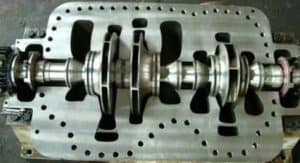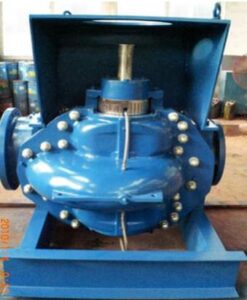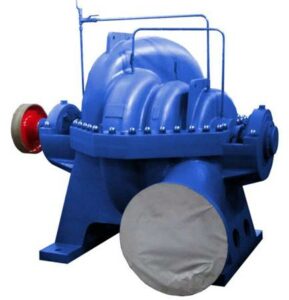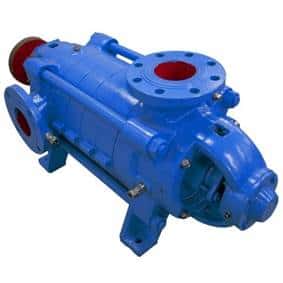Multistage Split Case Pump
What is a multistage split case pump?
A multistage split case pump is a specially engineered model of centrifugal pump comprising more than two impellers in a split casing. A split casing consists of two halves that join together using nuts and bolts. Depending on the joint’s orientation between the two halves, the pump casing can be either vertically or horizontally split. The units with a horizontal joint are known as multistage horizontal split case pumps, while those with a vertical joint are called multistage vertical split case pumps. The split casing allows for faster disassembly and maintenance of the pump’s internal components. Multistage split case pumps can generate extreme fluid pressure and higher flow rates because they pass fluid through several pumping stages. They are mainly used for pumping water and relatively thin pumped media with similar properties to water. Typical multistage split case pump applications include transporting clean, raw, or processed water in the process industries, water treatment plants, municipal water supply systems, and agricultural farms.
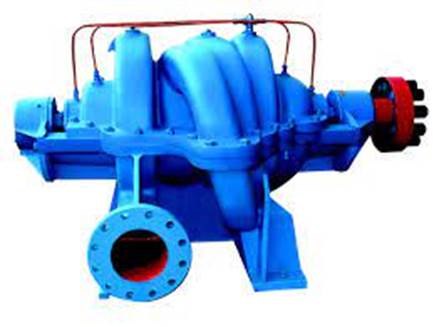
Figure: Showing the configuration of a multistage split case pump
Components of a multistage split case pump
Electric motor
The electric motor provides the mechanical power to run the pump. An electric motor has two main types: alternating (AC) and direct (DC) motors. The multistage split case pump manufacturer mainly employs the alternating current motor type for the units, either a single-phase AC or a three-phase AC induction motor. In most cases, the electric motor connects to the pump head via a long coupling.
Casing
The multistage split case pump’s casing is split into two halves that join together using nuts and bolts. The suction and discharge ports lie in one half of the split casing. The primary function of the pump casing is to cover the various components of the rotor assembly. Technically, the pump casing acts as a pressure containment vessel, preventing fluid leakage under pressure. The pump casing can be either vertically or horizontally split casing.
Figure: Showing a horizontally split pump casing.
Figure: Showing a vertically split pump casing.
Coupling
The multistage split case pump manufacturers usually employ a long coupling between the motor and the pump head. The primary purpose of the coupling is to connect the motor’s driver shaft with the rotating pump shaft, ensuring efficient transfer of mechanical torque to the pump head. The long coupling design facilitates quick access to the pump head without interfering with the motor assembly.
Shaft
The shaft is a rotating mechanical component riding on bearings. It carries the impeller and connects the entire rotor assembly to the motor drive shaft via a coupling. Vertical split case pump manufacturers design the shaft from quality materials such as stainless steel and alloy steel to resist corrosion and overcome vibrations during pump operation.
Impeller
The multistage split case pump mainly works with a particular impeller called a closed impeller. The impeller is a rotary component mounted on the pump shaft, featuring a series of backward-curved vanes. It imparts kinetic energy and fluid pressure to the water and moves it through the pump and distribution connections. Generally, closed impellers offer high hydrodynamic efficiency, fluid pressure, and flow rate. The multistage split case pump manufacturers create the closed type impeller in two main configurations: single-suction or double-suction impeller, using carbon steel, cast iron, or bronze.
Bearings
The multistage split case pump also comprises ball-type oil-lubricated bearings. The bearings support the pump shaft or the rotor assembly on either end and align the components correctly with the fixed ends under radial and axial forces. Further, the bearings also contain the rotor’s relative motion and minimize the friction between the rotating shaft and the stator.
How does a multistage split case pump work?
A multistage split case pump moves water from one location to another by converting the impeller’s kinetic energy into fluid velocity and static pressure energy through a series of pumping stages. When the pump starts, the pump shaft turns the impeller at the motor speed. As the impeller rotates, it creates a vacuum inside the casing, and the external atmospheric pressure pushes water into the pump casing through the suction port to fill the void. When water enters the first stage impeller, the rotation of the impeller generates a centrifugal force that directs the fluid along the impeller vane and pushes the liquid past the outer edges into the diffuser at a very high tangential velocity. In the diffuser, the flow velocity reduces, the fluid’s kinetic energy converts into a static pressure head, and the guides vanes direct the flow to the inlet of the second-stage impeller. This process continues until the last stage impeller and diffusing chamber, where the water attains the required pressure and discharges from the pump through the discharge port and delivery piping connections.
Types of multistage split case pumps
Multistage horizontal split case pump
In a multistage horizontal split case pump, the joint between the two halves of the pump casing is horizontal. This multistage split case pump manufacturer also designs this type for horizontal installations. The pump is perfect for indoor applications where the vertical space is limited. It is also easy to operate, dynamically balanced, and free of vibrations. Typical uses of the multistage horizontal pump include high-pressure water supply systems and HVAC for heating, ventilation, and air conditioning.
Figure: Multistage horizontal split case pump.
Multistage vertical split case pump
The multistage vertical split case pump features a vertical joint between the two halves of the split casing. The pump shaft can be installed in the vertical or horizontal position. It takes much less floor space for installation in the vertical position and is installed just like in hanging condition. However, it requires more headroom for installation and can only be coupled to an electric motor. This pump provides a stable and controllable output. It suits high-pressure and temperature applications.
Figure: Multistage vertical split case pump.
Applications of multistage split case pump
The multistage split case pumps are widely used to supply clean water at high pressure in many applications. They are evident in agricultural irrigation farmlands, firefighting equipment, wastewater, and power-generating plants. Typical applications of the pump include the following:
- Vertical split case pumps are used to move water at high flow rates and pressure in residential, commercial, and industrial water supply systems.
- They are used to support fire protection equipment.
- They also apply to transport water in municipal works and wastewater treatment.
- They are used to provide water for irrigation in agricultural farmlands.
- They are also used in air conditioning systems to supply heating or cooling water.
- They are also used in boiler feedwater piping systems.
- They are used in dewatering applications.
Advantages of a multistage split case pump
- A multistage split case pump can manage extremely high flow rates and water pressure.
- The pump’s split casing design increases the suction performance and balances the hydraulic axial forces, ultimately increasing the bearing life and improving reliability.
- A multistage split case pump is easy to maintain due to the long coupling between the electric motor and the pump head. The pump head can be accessed without dismantling the engine, thus saving service/ repair time.
- It provides high reliability and energy efficiency.
- The long coupling also ensures adequate space between the motor and the pump head, which prevents the pumped fluid from getting into the prime mover in case of mechanical seal failure.
- Additional bearing assembly between the electric motor and the pump head relieves a significant level of strain from the electric motor during operation, making the pump perfect for continuous operation.
- It has independent motors and pump shafts, which means that only one will need to be replaced if damaged.
- A multistage split case pump provides an even, stable, easy-to-adjust water flow rate.
Disadvantages of multistage split case pump
- They are complex to design due to the combination of various features.
- The initial acquisition and installation costs can be pretty high.
- Multistage split case pumps may experience mechanical seal problems. Such problems can relate to the drying out of seals or seal failure caused by infiltration and accumulation of gases in the seal chamber. Leakage in the mechanical seals can damage the motor.
Troubleshooting a multistage split case pump
The pump doesn’t start
- The power supply to the panel is insufficient. Ensure that the electric motor receives the right amount of voltage and current.
- There is a blown-out fuse or tripped circuit breaker. Inspect the multistage split case pump for a blown-out fuse and replace it if necessary.
- Poor motor wiring. Inspect the motor wiring against the multistage split case pump manufacturer’s wiring diagram and correct any shortcomings.
Insufficient discharge after startup
- The inline pump operation is reversed. Check that the direction of the motor rotation matches the direction of the multistage split case pump manufacturer’s arrow on the pump casing. Reverse the motor polarities.
- The check valve is installed incorrectly. Install the check valve properly or replace it.
- The pump inlet is blocked, or the impeller is clogged. Wash the channel and the impeller to remove any obstruction.
- There is air in the pump or suction pipework. Multistage split case pumps cannot prime with air on the suction side. Ensure that the pump or pipework is filled with water to drive out the air from the pump system.
The pump vibrates too much
- There are unbalanced components in the pump. Inspect and rebalance the multistage split case pump components as necessary.
- Some pump parts are loose. Tighten the components to the torque level recommended by the multistage split case pump manufacturers.
- The impeller is severely worn-out. Inspect and replace the impeller with another one from the multistage split case pump manufacturer if you find it fit.
- The shaft is bent. Dismantle and replace the shaft if necessary.
- There is excessive thrust due to mechanical failure. Inspect the pump assembly and correct any shortcomings.
The noise level is too high
- The pump is working in cavitation. Ensure that the net suction pressure head meets the multistage split case pump manufacturer’s specifications. Be sure to open the suction line valves fully.
- The rotating part rubs on the stationary component. Dismantle the pump and correct the rotor assembly.
- Some pump components are excessively worn-out. Inspect the rotor assembly for worn-out bearings or impellers and replace them if necessary.
- The pump is working outside the duty range. Ensure the correct duty range according to the multistage split case pump manufacturer’s manual.
Bearings have a short life
- The shaft is bent. Inspect and replace the shaft if necessary.
- The rotating components are rubbing against the stationary part. Correct the assembly.
- There is rusting of bearings from water in the housing. Inspect for water ingress avenues and seal them.
- The bearings are worn-out due to the shaft running out. Replace them if necessary.
Summary
A multistage split case pump comprises more than two impellers arranged in series within a casing divided into two halves that fit together using nuts and bolts. The pump’s bearing housing, inlet, and outlet ports sit on one side of the split casing. The joint between the two halves of the split casing can be vertical or horizontal. Multistage split case pumps differentiate themselves by the orientation of the split casing’s joint. The two main types of pumps are multistage horizontal split case pumps and multistage vertical split case pumps. The split casing facilitates faster disassembly and maintenance of the pump’s internal components. Multistage split case pumps are perfect for transporting water and relatively thin pumped media with similar properties to water. Typical applications include pumping clean water in process industries, irrigation farmlands, water treatment plants, municipal water supply systems, etc. Multistage split case pumps have excellent suction performance and balanced hydraulic axial forces, which lead to increased bearing life and improved reliability.

